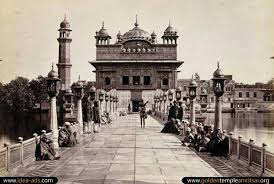Golden Temple Amritsar
 |
| Golden Temple |
About the Golden Temple Amritsar
Golden Temple
Introduction
 |
| Temple |
Shri Harmandir Sahib pronunciation is also non as to the Golden Temple is the holiest Gurudwara Sikhism, is located in the Amritsar, Punjab India was founded in 1577 by the fourth sikh , Guru Ram Das. The fifth sikh guru Arjan singh , designed Harminder sahib to be built in the center of the holy tank , upon its constructions, installed the Adi Granth , the holy scripture of Sikhism, inside the Harminder Sahib complex is also hoe to the akal takht by the sixth Guru,while the Harminder sahib is regarded as the abode of god spiritual attributes,the Akal Takht is the seat of God temporal authority.
History
 |
| Old Golden Temple |
The Harminder Sahib literally means the temple of the god.Guru Amar Das has ordered to Guru ram das to create a nectarous Tank as a place of worship for the Sikh regions.Guru Ram Das instructed his Sikh to join in the work, under Bhai Buddha superintendence and engaged laborers to assist them.
He said that to the Tank of nectar should be God's Home, and whoever bath in it shall obtain all spiritual
temporal advantages.During the progress of work, the hut in which the Guru first sheltered himself was expanded for
his residence, it is known as the Guru Mahal, or Palace.
Construction
Guru Arjan Singh Conceived the idea of creating a central palace of worship for the Sikh and designed it.
 |
| Golden Temple Under construction |
Earlier the planning to the excavate to the holy tank was chalked out by the guru Amar Das,the sixth Guru,but it was executed by Guru Ram Das under the supervision of Baba Buddha.The land for the site was acquired by the earlier Guru Sahibs on payment or free of cost from the Zamindars of natives villages.The plan to establish a town settlement was also made the construction works on the Sarovar and the town started simultaneously in 1570. The work on both projects was completed in 1577. In December 1588, Guru Arjan initiated the construction of the gurdwara and the foundation stone was laid by Hazrat Mian Mir on 28 December 1588.
The gurdwara was completed in 1604. Guru Arjan installed the Guru Granth Sahib in it and appointed Baba Buddha as the first Granthi(reader) of it in August 1604. In the mid-18th century it was attacked by the Afghans, by one of Ahmed Shah Abdali's generals, Jahan Khan, and had to be substantially rebuilt in the 1760s.
World's Largest's Free Kitchen(Langar's)
Harminder is a home to world's largest Kitchen.According to the Croatian Times ,it can serve free food for up to 100000 to 300000 people every in the day.At the Langar free kitchen ,is served to all visitors regard less of the faith ,religion or background.Vegetarian is served to ensure that all people.even those with dietary restrictions, can eat together as equals.The institution of the Sikh Langar or Free kitchen was started ,by the first Sikh Guru ,Guru Nanak. . It was designed to uphold the principle of equality between all people regardless of religion, caste, color, creed, age, gender, or social status, a revolutionary concept in the caste-ordered society of 16th century India where Sikhism began. In addition to the ideals of equality, the tradition of langar expresses the ethics of sharing, community, inclusiveness, and oneness of all humankind. Every Sikh Gurudwara (place of worship) has a langar, providing free vegetarian food for all comers.
 |
| Server |
The kitchen has two dining halls, which have a combined capability of 5000 people. People come up to and sit down to eat on the carpets on the floor, are served food by the volunteers, and are ushered out respectfully to make room for the next round of dinners.
Visting Guidelines
In keeping with the rule observed at all Sikh gurdwaras worldwide, the Harmandir Sahib is open to all persons regardless of their religion, color, creed, caste or gender. The only restrictions on the Harmandir Sahib's visitors concern their behavior when entering and while visiting:
 |
| Golden Temple Devoottee |
- Maintaining the purity of the sacred space and of one's body while in it:
- Upon entering the premises, removing one's shoes (leaving them off for the duration of one's visit) and washing one's feet in the small pool of water provided;
- Not drinking alcohol, eating meat, or smoking cigarettes or other drugs while in the shrine
- Dressing appropriately:
- Full body must be covered, no shorts
- Wearing a head covering (a sign of respect) (the gurdwara provides head scarves for visitors who have not brought a suitable covering);
- Not wearing shoes (see above).


Comments
Post a Comment